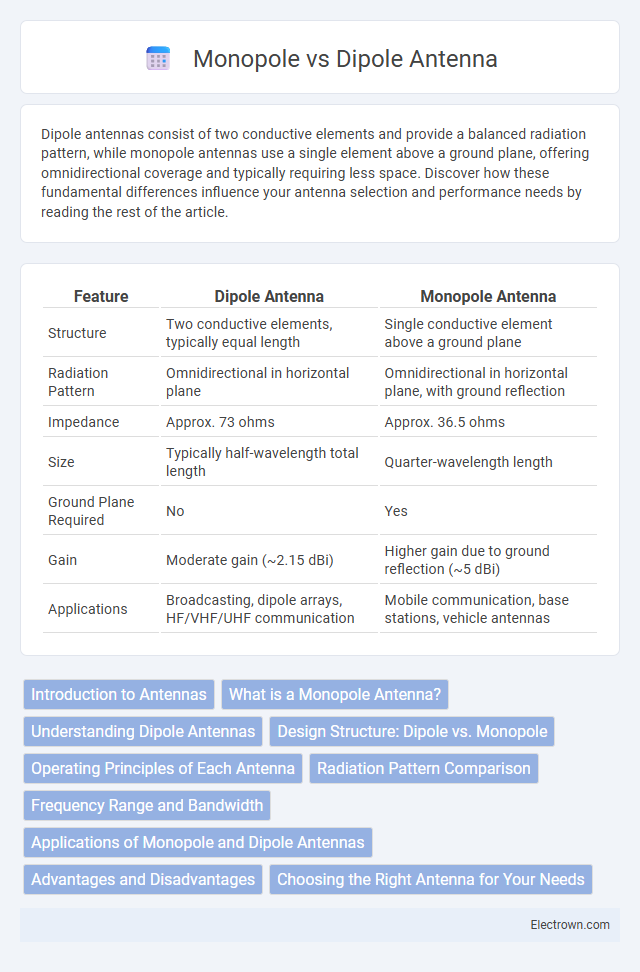Dipole antennas consist of two conductive elements and provide a balanced radiation pattern, while monopole antennas use a single element above a ground plane, offering omnidirectional coverage and typically requiring less space. Discover how these fundamental differences influence your antenna selection and performance needs by reading the rest of the article.
Table of Comparison
| Feature | Dipole Antenna | Monopole Antenna |
|---|---|---|
| Structure | Two conductive elements, typically equal length | Single conductive element above a ground plane |
| Radiation Pattern | Omnidirectional in horizontal plane | Omnidirectional in horizontal plane, with ground reflection |
| Impedance | Approx. 73 ohms | Approx. 36.5 ohms |
| Size | Typically half-wavelength total length | Quarter-wavelength length |
| Ground Plane Required | No | Yes |
| Gain | Moderate gain (~2.15 dBi) | Higher gain due to ground reflection (~5 dBi) |
| Applications | Broadcasting, dipole arrays, HF/VHF/UHF communication | Mobile communication, base stations, vehicle antennas |
Introduction to Antennas
Dipole antennas consist of two conductive elements that radiate radio waves efficiently, while monopole antennas use a single element above a ground plane, creating an image antenna below. Dipole antennas offer balanced radiation patterns and are commonly used in applications requiring omnidirectional coverage. Understanding the differences helps you select the right antenna type for optimizing signal transmission and reception based on your specific communication needs.
What is a Monopole Antenna?
A monopole antenna is a type of radio antenna consisting of a single conductive element mounted perpendicularly above a conductive surface or ground plane, effectively functioning as half of a dipole antenna. Monopole antennas are widely used in wireless communication systems due to their simple design, efficient omnidirectional radiation pattern, and compact size. Your choice of a monopole antenna can enhance signal transmission and reception, especially in applications requiring vertical polarization and limited installation space.
Understanding Dipole Antennas
Dipole antennas consist of two conductive elements oriented in a straight line, typically half a wavelength apart, creating a balanced radiation pattern ideal for transmitting and receiving signals. Compared to monopole antennas, dipoles provide more uniform coverage and better impedance matching, resulting in increased efficiency and reduced signal loss. Understanding dipole antennas helps you optimize antenna design for applications requiring reliable, omnidirectional communication.
Design Structure: Dipole vs. Monopole
A dipole antenna consists of two conductive elements, usually metal rods, oriented in a straight line with a central feed point, creating a balanced structure that requires a symmetrical feed. A monopole antenna, in contrast, features a single conductive element placed over a conductive ground plane, acting as a mirror to simulate the other half, resulting in an asymmetrical design with unbalanced feed. The dipole's design offers a bidirectional radiation pattern, while the monopole's structure provides an omnidirectional pattern in the horizontal plane, influenced by the size and quality of the ground plane.
Operating Principles of Each Antenna
Dipole antennas operate by creating a standing wave of current along two conductive elements, typically half a wavelength long, enabling efficient radiation and reception of electromagnetic signals through balanced currents. Monopole antennas function as a single conductive element mounted above a ground plane, utilizing the image theory to act like a dipole antenna's half, producing an electromagnetic field by unbalanced currents between the antenna and the ground. These fundamental differences influence impedance, radiation patterns, and suitability for various wireless communication applications.
Radiation Pattern Comparison
Dipole antennas exhibit a figure-eight radiation pattern with maximum radiation perpendicular to the antenna axis, creating nulls along the axis itself. Monopole antennas, typically mounted over a ground plane, produce an omnidirectional radiation pattern in the horizontal plane with a single main lobe radiating outward. The dipole's bidirectional pattern suits applications requiring coverage in two opposite directions, while the monopole's omnidirectional pattern offers uniform coverage around the antenna.
Frequency Range and Bandwidth
Dipole antennas typically offer a wider frequency range and broader bandwidth, making them suitable for applications requiring multi-band operation or frequency agility. Monopole antennas generally operate effectively at a narrower frequency range with more limited bandwidth, often optimized for specific frequencies or bands such as VHF or UHF. The bandwidth of dipole antennas can be enhanced by design modifications like fat dipoles or folded dipoles, whereas monopoles rely heavily on ground plane size and structure for bandwidth performance.
Applications of Monopole and Dipole Antennas
Monopole antennas are widely used in mobile communication devices, vehicle-mounted radios, and low-frequency broadcasting due to their simple design and omnidirectional radiation pattern. Dipole antennas find applications in television reception, FM radio, and wireless networking systems because of their balanced structure and efficient dipole radiation characteristics. Both antenna types are essential in various wireless communication fields, with monopoles preferred for compact designs and dipoles favored for more stable and directional signal transmission.
Advantages and Disadvantages
Dipole antennas offer balanced radiation patterns and are generally easier to match with transmission lines, providing efficient signal transmission with moderate directional gain. Monopole antennas require a ground plane for operation, resulting in a simpler design and smaller size, but often suffer from uneven radiation patterns and reduced bandwidth compared to dipoles. While dipoles excel in stability and bandwidth, monopoles are favored for compact installations despite their dependence on ground plane quality and potential signal distortion.
Choosing the Right Antenna for Your Needs
Selecting between a dipole and a monopole antenna depends on your specific application, frequency range, and space constraints. Dipole antennas offer balanced radiation patterns and are ideal for medium-range communications, while monopole antennas provide omnidirectional coverage with a simpler design and smaller footprint. Your choice should consider factors like installation environment, desired signal directionality, and available ground plane to ensure optimal performance.
Dipole vs Monopole antenna Infographic

 electrown.com
electrown.com